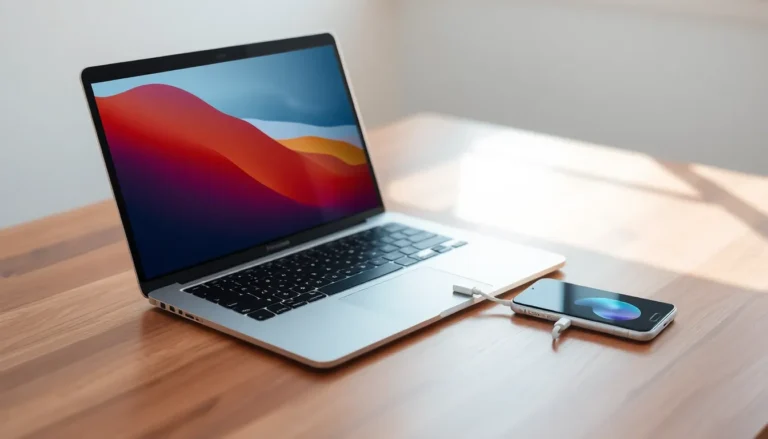If you’ve found yourself staring at your Mac, wondering why ShotScribus is still hanging around like that one friend who overstays their welcome, you’re not alone. Sometimes software just doesn’t click, and it’s time to let go. Uninstalling ShotScribus might feel like a daunting task, but fear not! This guide will walk you through the process quicker than you can say “I need my storage space back.”
Table of Contents
ToggleUnderstanding Shotscribus Software
ShotScribus is a desktop publishing application designed for creating professional-quality documents. This software serves graphic designers, publishers, and anyone interested in layout design tasks. Users appreciate its open-source nature and flexibility.
Overview of Shotscribus
ShotScribus offers robust features that include support for vector graphics, typography, and color management. It enables users to produce print-ready PDFs and interactive forms. Additionally, it provides tools for managing text, images, and layout efficiently. The application supports various file formats, enhancing its versatility in different design workflows. Many users choose ShotScribus due to its rich functionality combined with zero cost.
Reasons for Uninstallation
Uninstallation of ShotScribus occurs for several reasons. Users may face performance issues, such as lag or software crashes, which disrupt workflow. Compatibility problems with other applications often lead to frustration, prompting users to seek alternatives. Some individuals find the learning curve steep, making it less appealing for beginners. Storage concerns arise as well, as the application takes up space that users might prefer for other programs or files. Specific features may not meet user needs, leading to the desire for a different software solution.
Preparing to Uninstall Shotscribus

Before uninstalling ShotScribus, users must take a few important steps to ensure a smooth process. These steps help prevent data loss and make the transition easier.
Backing Up Your Projects
Backing up projects acts as a precaution against data loss during uninstallation. Users should identify their active projects within ShotScribus. After determining which files to save, export them in a compatible format, such as PDF or SVG. Storing backups on an external drive or cloud service also provides extra security. Regular backups maintain project accessibility in case of unforeseen issues.
Closing the Application
Closing the application ensures that all processes end before proceeding with the uninstall. Users should locate ShotScribus on their Mac and check if it’s currently running. Quitting the application can be done directly from the menu bar by selecting “ShotScribus” and then “Quit ShotScribus.” This action prevents any conflicts during the uninstallation, allowing the process to complete without interruptions.
Uninstalling Shotscribus on Mac
Uninstalling ShotScribus on a Mac can be straightforward. Users can choose from two effective methods.
Using the Drag-and-Drop Method
This simple method involves dragging the ShotScribus application to the Trash. First, locate the app within the Applications folder. After finding the icon, click and hold to drag it to the Trash. Emptying the Trash removes the application entirely from the system. It’s essential to note that this method may leave behind preferences or support files. Users can manually search for these files in the Library folder. Checking both the Application Support and Preferences subfolders ensures a clean uninstall.
Using Terminal Commands
For users comfortable with the Terminal, commands offer a deeper uninstallation approach. First, open Terminal, which is located in Applications under Utilities. Users then enter specific commands to remove the application and related files. The command sudo rm -rf /Applications/Shotscribus.app deletes the app. Following this command, users might want to execute additional commands to clear preference files. These commands include sudo rm -rf ~/Library/Preferences/org.shotscribus.plist and sudo rm -rf ~/Library/Application Support/Shotscribus. Successful execution leads to a more thorough removal of all associated files.
Post-Uninstallation Steps
After uninstalling ShotScribus, users should follow essential post-uninstallation steps to ensure a clean system. Removing any leftover files enhances overall performance and frees up additional space.
Removing Related Files
Removing related files can improve system efficiency. Users must access the Library folder to find remnants of ShotScribus. Search for folders named “ShotScribus” or files with similar names, including preferences and support documents. Users commonly find these in the following subdirectories:
~/Library/Application Support/~/Library/Preferences/~/Library/Caches/
Deleting these items ensures no traces of ShotScribus remain on the system.
Checking for Remaining Components
Checking for remaining components confirms a thorough uninstallation. Users can utilize built-in search functions to locate any stray files associated with ShotScribus. The Spotlight tool provides a convenient way to search for application names or keywords.
Often, users can inspect the folders mentioned earlier, along with:
~/Library/Logs/~/Library/Saved Application State/
Reviewing these areas helps identify any overlooked files, ensuring the system is completely devoid of unwanted remnants.
Uninstalling ShotScribus from a Mac doesn’t have to be a daunting task. By following the outlined steps users can easily reclaim valuable storage space and enhance their system’s performance. Whether opting for the simple drag-and-drop method or the more thorough Terminal commands both approaches ensure a clean removal of the software.
Post-uninstallation tasks are equally important. Taking the time to eliminate any leftover files will help maintain a tidy system and prevent potential conflicts in the future. With these strategies in hand users can confidently explore alternative software solutions that better suit their needs while enjoying a streamlined Mac experience.








